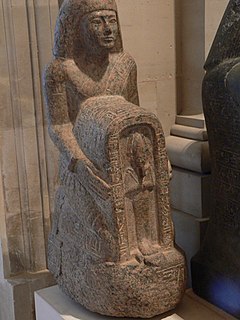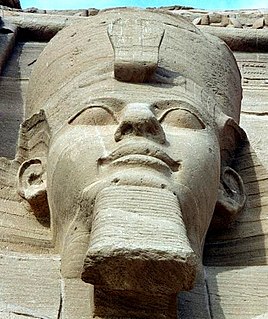
Meryatum was an Ancient Egyptian prince and High Priest of Re, the son of Pharaoh Ramesses II and Nefertari.

The Ancient Egyptian Noble Paser was vizier, in the reigns of Seti I and Ramesses II, during the 19th dynasty. He would later also become High Priest of Amun.
Paser II was the son of the High Priest of Min and Isis named Minmose. Paser came from a very well-connected family. One uncle was the High Priest of Amun Wennenefer and another uncle was the troop commander of Kush named Pennesuttawy. Through Wennenefer, Paser was related to Amenemone, Amenemope and Hori, the High Priest of Anhur.

Pahemnetjer(p3-ḥm-nṯr; "servant of the god", "priest") was a High Priest of Ptah during the reign of Ramesses II. Pahemnetjer succeeded Huy as High Priest of Ptah and was in turn succeeded by his son Didia.
Didia was High Priest of Ptah during the reign of Ramesses II. Didia succeeded his father Pahemnetjer into the office of High Priest of Ptah.
Nebwenenef was High Priest of Amun at the beginning of the reign of Ramesses II during the 19th Dynasty. Prior to that, Nebwenenef had served as High Priest of Anhur and High Priest of Hathor during the reign of Seti I and possibly even earlier.
Parennefer also called Wennefer was a High Priest of Amun during the reigns of Tutankhamen and Horemheb. He was previously thought to date to the time of Ramesses II, but he is now dated to the end of the Eighteenth Dynasty. Parennefer was more firmly put at the end of the Eighteenth Dynasty after extensive excavations of his tomb in Thebes in 1990-1993.

The Ancient Egyptian Noble Prehotep II was Vizier, in the latter part of the reign of Ramesses II, during the 19th dynasty.
Pennesuttawy was a Military Commander and Superintendent of the Southern Lands (Kush) during the beginning of the Nineteenth dynasty of Egypt.

Wenennefer was an ancient Egyptian High Priest of Osiris at Abydos, during the reign of pharaoh Ramesses II of the 19th Dynasty.

Yuyu was an ancient Egyptian High Priest of Osiris at Abydos, during the reign of pharaohs Ramesses II and possibly Merenptah of the 19th Dynasty.
Qeni was the Superintendent of the Granary during the reign of Ramesses II. Qeni and his family came from Asyut.
Hori was an ancient Egyptian High Priest of Osiris at Abydos, during the reign of pharaohs Ramesses II.
Mery was an ancient Egyptian High Priest of Osiris at Abydos, during the reign of pharaoh Sety I and Ramesses II of the 19th Dynasty.
Hat was an ancient Egyptian High Priest of Osiris at Abydos, during the reign of pharaoh Sety I of the 19th Dynasty.
Anhurmose was an Ancient Egyptian official of the New Kingdom. He was the high priest of Anhur under Merenptah, but started his career as a military man, most likely under king Ramesses II.
Amenmose, Son of Pendjerty was a royal scribe from the time of Ramesses II. Amenmose was the son of the judge Pendjerty and the sistrum bearer of Amun, Mut and Khonsu, named Mutemonet.












